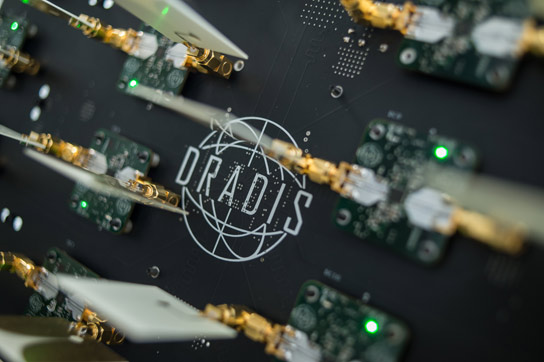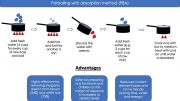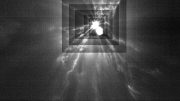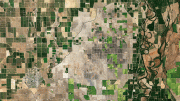
D.R.A.D.I.S., an impulse-based radar system for real-time 3-D imaging, won two of the top three prizes at Rice University’s annual Engineering Design Showcase. Credit: Jeff Fitlow/Rice University
Engineering students from Rice University have developed a real-time 3D radar system as a concept for a next-generation collision-avoidance system for the auto industry.
Spencer Kent stands nervously in front of Team D.R.A.D.I.S.’ booth at Rice University’s annual Engineering Design Showcase. Judging begins in about 10 minutes, and his teammate Galen Schmidt is frantically typing computer code into a laptop beside the team’s custom-made radar system.
Kent, Schmidt, and teammate Jeremy Hunt finished assembling their device — an impulse-based radar for real-time 3-D imaging — less than 12 hours earlier in an epic all-nighter. The trio can’t recall if it was their third or fourth sleepless night of the past week. They’ve lost count. “We knew it would be a race to the finish,” Kent said. “We’ve been doing this all semester.”
Three hours later, the team would be called to the award podium twice within a few short minutes to receive two of the showcase’s top three prizes. It was the first time that has happened in the contest’s history. D.R.A.D.I.S., which stands for “dynamic radar and digital imaging system,” captured the $5,000 top prize for Excellence in Engineering as well as a $3,000 Willy Revolution Award for Innovation in Engineering Design.
The system was designed as a proof of concept for a next-generation collision-avoidance system for the automotive industry. Current radar systems in cars sense when objects are near, but they do not attempt to image them. D.R.A.D.I.S. does. Its 16 pulse-radar antennae feed data to a high-end gaming graphics card that uses more than 2,000 processing cores to complete about a trillion calculations per second.
“They performed at or above the level I have seen from seasoned, practicing engineers,” said D.R.A.D.I.S.’ faculty mentor Gary Woods, professor in the practice of electrical and computer engineering. “The system design and integration were both a tour de force and high-wire act.”
Woods said the trio set a “very aggressive” schedule that called for custom designs or implementations of antennas, printed circuit boards, low-level software, and high-level image reconstruction algorithms.
“They got the system to work just hours before the design showcase,” he said. “There was no room for error.”
For many, the word radar still evokes Cold War-era images of blips on screens and rotating antennae. That kind of radar works by sending out microwaves in a continuous beam. When the microwaves strike an object, some are reflected back, and by reading those reflections, “continuous radar” systems can tell how far away an object is and how fast it is moving.
D.R.A.D.I.S.’ “pulse radar” technology is different. It uses short bursts of low-power microwaves at a frequency around 10 gigahertz. The power level is about 10 million times less than a cellphone, which means the pulses travel only a short distance. But because they are pulses, they have a very large bandwidth, which means the reflected signals contain a great deal of information about the target.
To build their antenna array, Kent, Hunt, and Schmidt purchased 16 off-the-shelf pulse-radar transceiver chips from startup XeThru, a reprogrammable piece of hardware called a “field programmable gate array” (FPGA) and an ARM processor like the ones used in smartphones. Almost everything else in D.R.A.D.I.S. was custom-built, including the 16 circuit boards for each transceiver and the backplane circuit board, which allows the transceivers to communicate with the FPGA and remain synchronized to within three-trillionths of a second. The team also wrote more than 10,000 lines of computer code.
The team’s sponsor, Aydin Babakhani, assistant professor of electrical and computer engineering at Rice, said Team D.R.A.D.I.S.’ attempt to incorporate off-the-shelf, low-power radar transceivers into a real-time 3-D imaging system is a first.
“They have not yet shown it is generating 3-D images, but they are still working and hope to finish before commencement,” Babakhani said. “If they do, we believe this will be the world’s first impulse-based, real-time 3-D imaging system.”
He said D.R.A.D.I.S. is important as a proof of concept because it shows what also might be accomplished using research-grade transceivers that work at more exotic wavelengths, such as the terahertz range.
“In terms of potential applications, the real-time image processing that the team has demonstrated could be used for security screening, for the automotive industry, and for medical applications,” Babakhani said.
“With security, for example, the full-body scanners that are already used for airport screening are very expensive and huge,” he said. “If D.R.A.D.I.S.’ technology were fully developed, it could provide a similar type of screening at a fraction of the cost, and it would be far more compact.”
Kent, Schmidt, and Hunt said the prior research of graduate student Peiyu Chen, a member of Babakhani’s research group, was helpful in the early stages of the design phase last fall. Chen had already published research about image processing with a single transceiver setup that had similarities to the multi-antenna device the team envisioned.
“We weren’t sure, at that point, which type of radar we were going to use, but we thought we should at least be familiar with what he had done,” Schmidt said. “He had existing code that he was using to generate images off of the data that he was using from his project, so we looked at that code, determined how it worked, and began thinking about how we could scale that up and improve it for our system.”
Prior to the showcase, the team spent well over 500 hours writing computer code for D.R.A.D.I.S. For starters, Hunt compiled a custom version of Embedded Linux for the system. Image processing was done on an NVIDIA graphics card, which boasts four teraflops of capacity and a whopping 2,048 processor cores. Schmidt also wrote the image processing code using an NVIDIA processing library called CUDA. In addition, the team had to create its own software for the graphical user interface as well as software to reconfigure the FPGA controller.
Although the team members are slated to graduate this month with degrees in electrical engineering, D.R.A.D.I.S. will live on in Babakhani’s lab. Chen and other members of the research group are working with the team to transfer all the software and hardware so they can adapt the setup to work with various chipsets they are researching in the lab.
“We’re all hoping it gets used in the future,” Hunt said. “From the beginning, our goal was to build D.R.A.D.I.S. in such a way that it’s modular, with the idea that Dr. Babakhani and his students could pop in a different chipset and build upon what we’ve done.”









Be the first to comment on "Rice Engineers Develop Real-Time 3D Radar System"